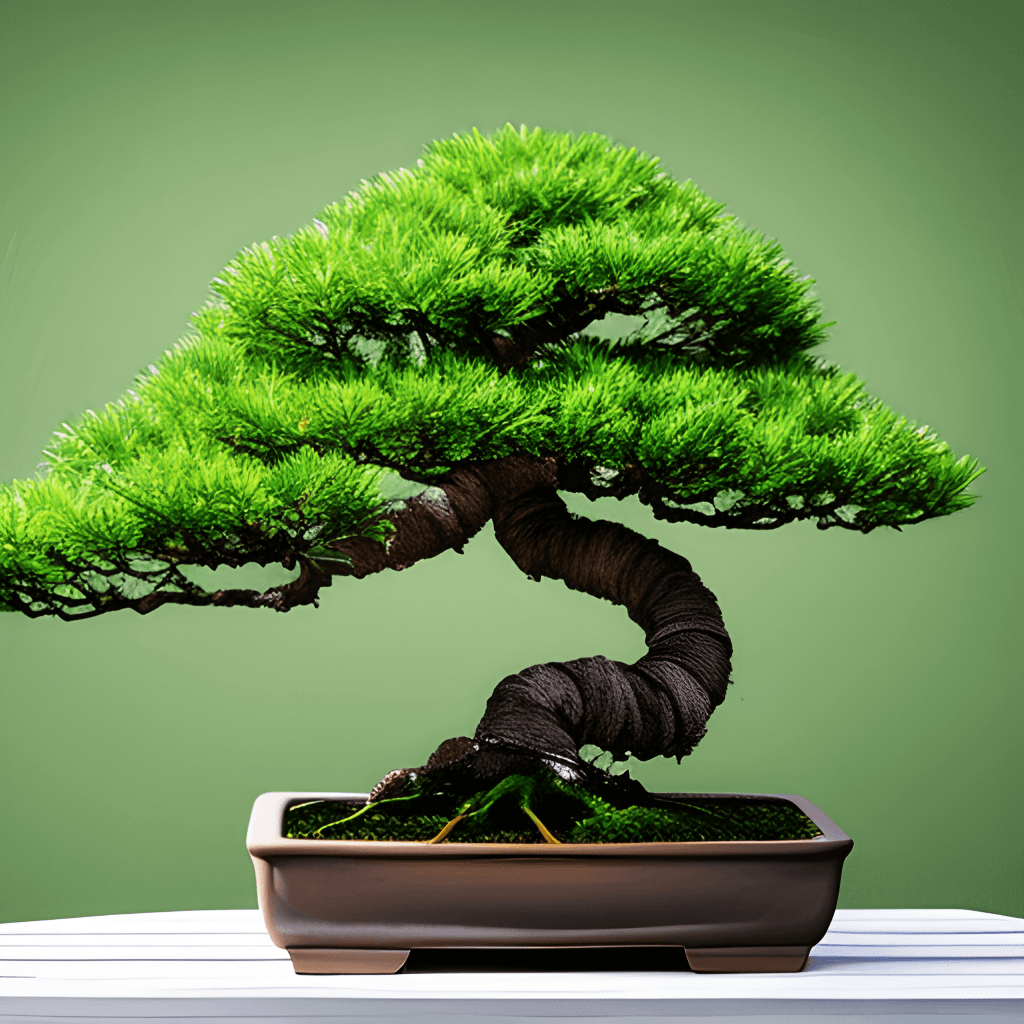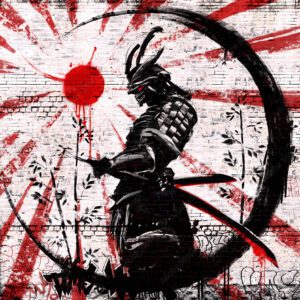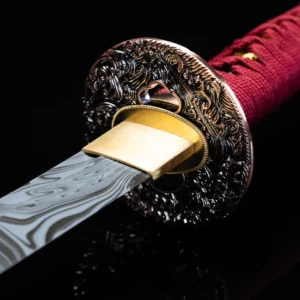
Bonsai is a Japanese word whose meaning can be translated as “ planted in a tray ” or “ planted in a flat pot ”; in fact it is written with the kanji 盆栽, which can be translated respectively with the words ” tray ” and ” planting “.
In practice, a bonsai is a miniature live tree that is planted in a pot .
As well as many other aspects of Japanese culture , the art of bonsai was imported into Japan by Buddhist monks from China, where this art is called ” penjing “; the Japanese version, however, has evolved totally independently of its original version, with its own rules, styles and techniques, and has acquired such fame that nowadays on an international level this art is almost always referred to by its Japanese name.
The miniaturization of the plant is one of the main aspects of a bonsai (but not the only one); for example, a Japanese black pine in nature reaches 40 meters in height with a trunk diameter at the base of up to about 2 metres, with needle-like leaves up to 12 cm long and strobili (without going into the technical explanation: the pine cone) also they are very large.
A bonsai, on the other hand, perfectly maintains all its botanical characteristics, but with very small dimensions and proportions (height and thickness of the trunk, branches, leaves, needles, flowers, etc.), ranging from one meter in height to the “large” versions less than 20 cm for the “small” ones, up to under 10 cm for the “mini” ones.
A Japanese bonsai wants to replicate the perfection that a tree can have in nature , with all its most varied peculiarities, but in a “portable” version; furthermore, by looking at it you must always receive a sense of vitality and strength, as well as “wisdom” and longevity for older specimens or for those that have branches and trunks with dry wood.
In addition to miniaturization, accompanied by a perfect mass and proportionality of the parts, other aspects that characterize a bonsai are :
- The root system , which should always be circular in shape, and which gives the sensation of perfect stability of the plant and anchoring to the ground
- The trunk , with a more powerful base than the apical part, visible for 2/3 of the overall size of the bonsai (there are exceptions based on the style) and a bark with a worn and ancient appearance
- The branches , diversified into primary (the largest and lowest), secondary and tertiary (smallest and placed at the top), arranged in such a way that, as happens in nature, the lowest part appears more powerful and of advanced age, compared to to the apical part; they should never cross each other or be confused and scattered; they should have fewer branches inside and more as you go outwards; furthermore, there is a tendency to place small branches on the front rather than larger branches on the back (again very dependent on the style)
- The foliage , made up of small dense branches, which make clear the vitality of the plant (a bonsai, being a living plant, never stops growing and renewing itself)
- Dry wood and debarking (in Japanese called jin if it concerns a branch, shari or sharimiki if it concerns the trunk), which give the bonsai an ancient and ancient appearance, a sign of cataclysms and natural events, such as a branch broken by the wind or weight of snow, a trunk struck by lightning, or even a more or less large part that has had to endure a prolonged period of drought; Even the cavities, interspaces and irregular deformations of the trunk (in Japanese called uro ) are an important part of giving “antiquity” to a plant
- The vase , or the completion of the bonsai; without a pot, obviously, the plant could not be called bonsai; there are some basic rules on the size of the pot, which vary based on the style of the bonsai or the height and thickness of the trunk; for example, in the upright style the length of the vase will be 2/3 of the height of the trunk, while the height of the vase will be the same as the thickness at the base of the trunk; for the waterfall style you will opt for a tall and deep vase while for a grove style the vase will be shallow; the vases can have rectangular, oval, round, square, hexagonal, octagonal shapes, with beveled edges or not, with feet of various shapes and with possible decorations; the important thing is that it never distracts the observer’s attention from the plant.
Even the dimensions of a bonsai have specific names and characteristics, in fact, based on the height, we talk about:
- Mame , under 10 cm
- Shoin , between 10 and 20 cm
- Kifu , between 20 and 35 cm
- Chuhin , between 32 and 60 cm
- Ogata , over 60 cm

As regards the age of a bonsai , it must be said that it is necessary to differentiate the age of the plant itself from the age of the bonsai, i.e. from the moment a particular plant begins to be cultivated to become a bonsai. In fact, a bonsai can be created from a seed or by cutting (cut branch or leaf, from which the roots grow), which means that the plant will already be born as a bonsai.
But it can also be created by collecting a plant in nature, by layering (a branch is made to root while it is still attached to the tree and then cut and buried) or by grafting (one or more small branches are “inserted” into a larger trunk large already rooted). In the latter cases, it goes without saying that the plant could even have tens or hundreds of years of life, but its potting, and therefore the fact that it is a bonsai, will have a different duration.

Among the oldest bonsai still in existence , we could mention a Japanese juniper more than 1,000 years old and one about 700 years old kept in the Mansei-en garden of Omiya, a Japanese white pine about 250 years old in the Toju-en garden also in Omiya, a Picea jezoensis (conifer) about 1,000 years old exhibited at the Omiya Bonsai Museum, another Japanese white pine more than 500 years old preserved in the Tokyo Imperial Palace .
Furthermore, right in Italy, at the Crespi Bonsai Museum (the first permanent bonsai museum in the world) a Ficus Retusa Linn over 1,000 years old is on display which could be the oldest bonsai (or perhaps more a penjing?) in the world, lying in the largest bonsai pot in the world!
- Trees used as bonsai
- Bonsai styles
- History of bonsai
- Differences between Japanese bonsai and Chinese penjing
Trees used as bonsai
Practically, any tree present in nature can become a bonsai ; for the choice, obviously very dependent on the area, or continent, of which the plant is endemic. In Japan, for example, despite the creativity of the bonsai artist, there are some species of plants that are particularly used as they are native there.
The most famous species is certainly the pine ; among the native Japanese versions there are the Japanese black pine and the Japanese red pine which grow near the coasts and the Japanese white pine which grows in the mountains.
Juniper , also present in various species including Juniperus rigid and Shimpaku , lends itself very well to dry wood (jin and shari) and to having twisted trunks and branches . Cryptomeria japonica (misnamed Japanese cedar, even though it does not belong to the cedar genus) is also widely used, even in the shohin versions.
The Japanese yew , poisonous in all its parts with the exception of the red arils (similar to berries, which grow outside the seed, which is also poisonous), has a very slow growth and also lends itself well to jin. The Japanese Larch is very present in the mountains of central Japan, therefore it is easy to find it in the bonsai version.
All of these mentioned above are conifers; among the deciduous plants, however, particularly used are Japanese maples , or palmate maples, whose leaves in autumn take on a phenomenal color that varies from fiery red to yellow, passing through purple and orange; these trees are also known as momiji .
Ginkgo , a prehistoric tree that becomes an immense mass of gold-colored leaves in autumn.

The Azaleas , in the Satsuki and Kurume versions , explode with wonderful flowers of the most varied colors in the months of May and June. Japanese Wisterias also bloom with cascades of colorful flowers between April and May; the latter are only found in medium or large bonsai versions precisely because their flowering is very extensive.
Then there are the Zelkova (or Japanese Elms) and various fruit trees .
Bonsai styles
A Japanese bonsai follows a series of well-defined rules in its composition, which also vary based on the style you want to adopt; However, it is essential that each bonsaist master gives the plant its own character and its own “soul”, otherwise all specimens would be mere copies of themselves.
To learn more, I wrote an article dedicated to the styles and shapes of bonsai .
History of bonsai
Bonsai is the Japanese reading of the Chinese word penzai , the latter also known as penjing .
The origin of miniaturizing trees and placing them in ceramic vases was born in China around 1300 years ago during the Tang Dynasty ; in the tomb of Prince Li Xian (653–684) there is a depiction on a wall of a person with a vase in his hand inside which there are small trees.
There are no official documents indicating who, and in what precise period, began cultivating bonsai in Japan , but it is thought that the idea, and the first specimens, were imported from China at the beginning of the Heian period by Buddhist monks.
The first written document that refers to bonsai is the ” Saigyo Monogatari Emaki “, a scroll where miniature potted trees are depicted, dating back to the very early Kamakura period (1195). There are also other scrolls dating back to the Kamakura period in which miniaturized trees are depicted.
It was in the first part of the Edo period that the culture of bonsai began to expand among the daimyo and samurai throughout Japan, who used them to compete with each other during the shogun’s visits; in the second part of the Edo period, however, bonsai became an art open to the entire population , regardless of social class.
Many bonsai dating back to the 17th century are still alive; probably the oldest is the one preserved in the Imperial Palace of Tokyo, a Japanese white pine called “ Sandai-Shogun-No Matsu ” and part of the National Treasures of Japan, of which there are official documents that indicate Tokugawa Iemitsu as one of its curators .
In 1829 the book “ Sōmoku Kin’yō-shū ” was published , the first in which the basic techniques for the cultivation of pine bonsai were defined ( on the Hathi Trust website you can find the original copy of the book kept at the University of Michigan and available for free ).
It was, however, during the Meiji period (1868 – 1912) that Bonsai was standardized and considered a true “art” , also spreading to Europe and the USA; Emperor Meiji pushed bonsai culture a lot, so much so that all the officials who were against it or who didn’t like it (at least on the surface) lost importance, recognition and work.
During the Second World War, many important specimens, including those kept in the Imperial Palace, died due to American bombing, but fortunately many others were saved. With the end of the war there was first a decrease in interest in bonsai, followed by an expansion at an international level, also thanks to shows and exhibitions.
In 2010, the Bonsai Art Museum opened in Omiya (Saitama) , just north of Tokyo , the first public museum dedicated to bonsai, where thousand-year-old specimens of rare beauty (seen in person) are on display, as well as information on every like on bonsai and the history of the very famous Bonsai Village of Omiya , born after the great Kantō earthquake of 1923.
Differences between Japanese bonsai and Chinese penjing
The art of Japanese bonsai differs from that of Chinese penjing in various aspects which concern not only the shapes of the plant, but also of the vase and the “scenography” that is represented.
For example, in Japanese bonsai you will never find anything more than the tree and the undergrowth, these being what the bonsai wants to represent, that is, a miniature version of a tree as it would appear in nature.
Chinese penjing , on the other hand, does not necessarily want to represent a tree, but focuses on an entire landscape; this means that in addition to plants, scenographic elements such as figurines of people, houses, rocks, water, etc. are often used.

Another characteristic of the Chinese version is the use of vases that do not follow rules and proportions consistent with the plant they contain, furthermore they are more varied, often featuring paintings, writings or colored drawings; the vases of the Japanese counterpart, however, are chosen based on the style of the plant and are more sober in shapes and colours.
Again, in bonsai everything is miniaturized , trunk, branches and vegetation and we always try to harmonize and balance the overall result, while in penjing the leaves and the volume of the plant are not taken into consideration; it is only the trunk and the main branches that are of considerable importance.
Not only! The penjing want to represent the tree in the most real and natural way possible, which means that its forms are often without order, tangled, extreme, almost exaggerated and imaginative (and in fact if you think about it, in nature trees do not grow following strict rules). Bonsai, on the other hand, must follow a precise order, refined and refined down to the smallest detail .

Despite all these differences, however, it will not always be easy to distinguish a bonsai from a penjing.


